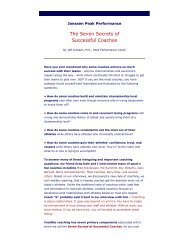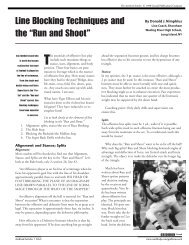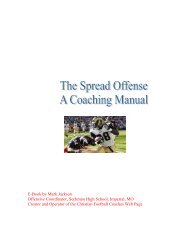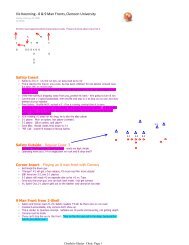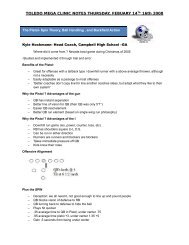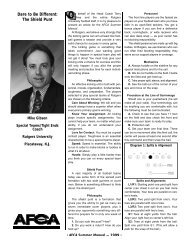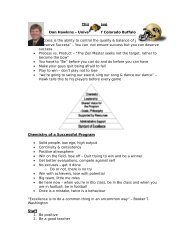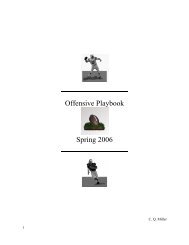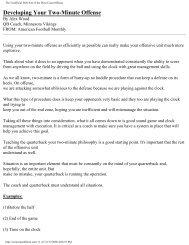Untitled - Fast and Furious Football
Untitled - Fast and Furious Football
Untitled - Fast and Furious Football
You also want an ePaper? Increase the reach of your titles
YUMPU automatically turns print PDFs into web optimized ePapers that Google loves.
28 FOOTBAIL COACHING STRATEGIES<br />
The quarterback decid€s priorto the snap <strong>and</strong><br />
just after the snap whether h€'s soing to thrcw<br />
him the ball or not. The quart€rback takes five<br />
quick steps. Notice I said five big steps in the Z'<br />
in. Now that we're thmwing out, the QB takes<br />
frve qaicA steps. He can't lead the receiver with<br />
the pass because any time you lead a receiver who<br />
is mnning parallel to the ball, he'lI never catch<br />
up to the ball .<br />
Throw dgbt at the man's hip.Ilyou throw into<br />
his body, the defensiv€ back doesn't have any way<br />
to get to it. What we are trying to get here rs the<br />
defensive back giving ground this way <strong>and</strong> then<br />
losine lateral gound thh way. That'E on single<br />
On this pafticular pattern both receivers do<br />
the same thing, but I would say most often the<br />
flanker gets it. The tight end tak€s an imide release,<br />
goes straight up the field, <strong>and</strong> runs a fuU<br />
speed cmssing pattern, but never crosses the ball.<br />
The tight end on his basic crossing pattern is the<br />
one you go to on man-under dcfense. If a team is<br />
running rnan-under, that kind of an out rs surcide.<br />
So ifour quaderback sees inside-out coverage<br />
on v,'rde receivers, reasonably close, his drop<br />
now goes right to the tight end; he's looking for<br />
the tight end to beat a man-under linebacker.<br />
M Pattem<br />
The backs play a key rcle. They check the backers<br />
on a blitz.After reading for the blitz, the back<br />
r-uns what we call an M pattern .<br />
In the M pattern, the back moves 1 1/2 to 2<br />
yards back from his blocking position. When he<br />
is 61ard. deep <strong>and</strong> 3 yards out.id. the offen"ite<br />
tackle, he turns upfield looking lor th€ M pat-<br />
/\<br />
FIGURE 5<br />
\,<br />
)^cc<br />
\'.<br />
I<br />
FIGUHE 6<br />
WE<br />
\oc<br />
\<br />
b<br />
l<br />
I s<br />
N<br />
d<br />
nght end oplion versus<br />
N<br />
T<br />
1<br />
"" t)<br />
c--<br />
On the M pattem, the weak linebacker some<br />
callhim a defensive end-takes away the square<br />
out, we hold the ball, <strong>and</strong> pop it fisht off to the<br />
hauback (see Figue 5).<br />
There's also a tight end option off the double<br />
lqLare-out patt€m. As you can s€e in Figurc 6,<br />
wh€n both middle lineback€ru coverbacks to the<br />
outside, <strong>and</strong>blitz one man, thiB isolates our tight<br />
end on a backex He has a good chance ofbeating<br />
the backer.<br />
Hook Patten<br />
Now let's look at the seven-step drop patteln. This<br />
is one play that we've almoBt worn out.<br />
On a seven-step drop patterl our receivers will<br />
maneuver Werc going to run a blue left for us, a<br />
right, which is motion, <strong>and</strong> we'rc going to r"un a 79,<br />
which r. $ eak flo$ pasq protFction. NowX rs going<br />
to run a pattem on the weak side (see Figure 7).



